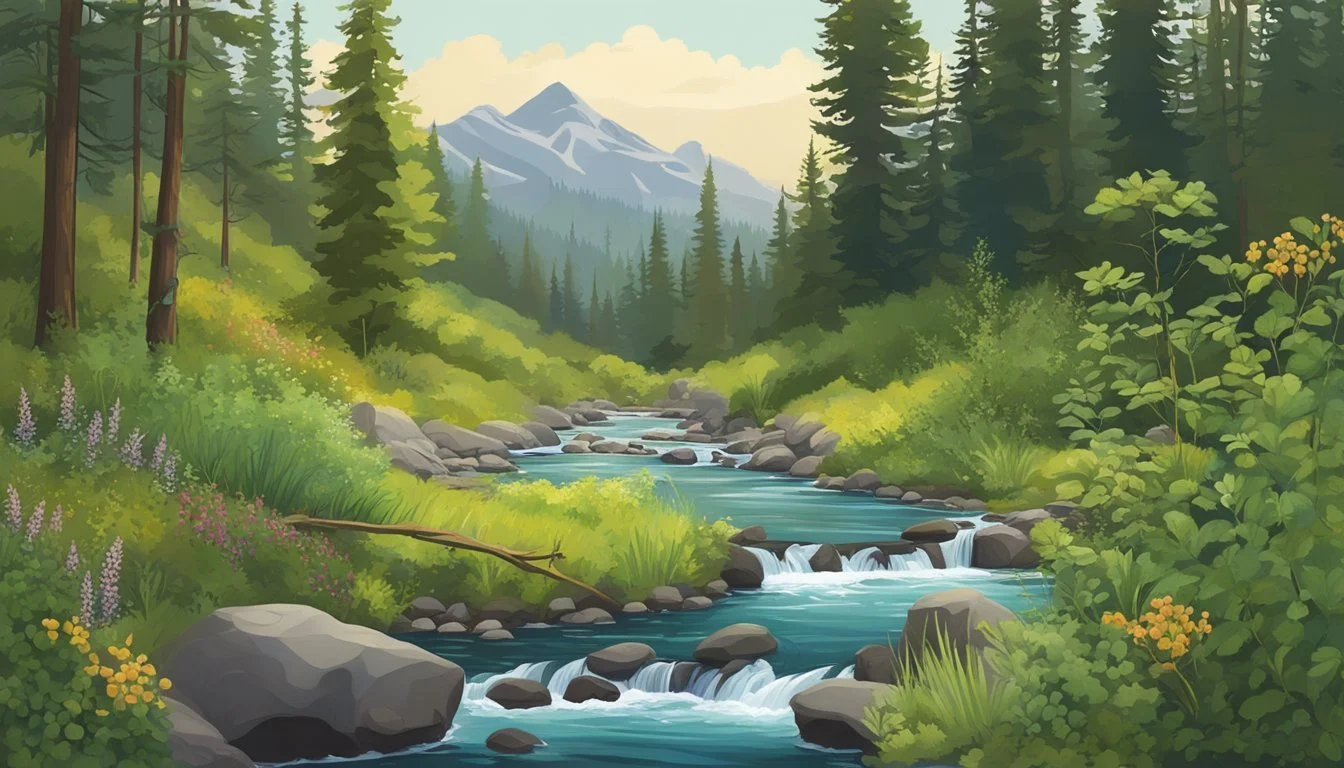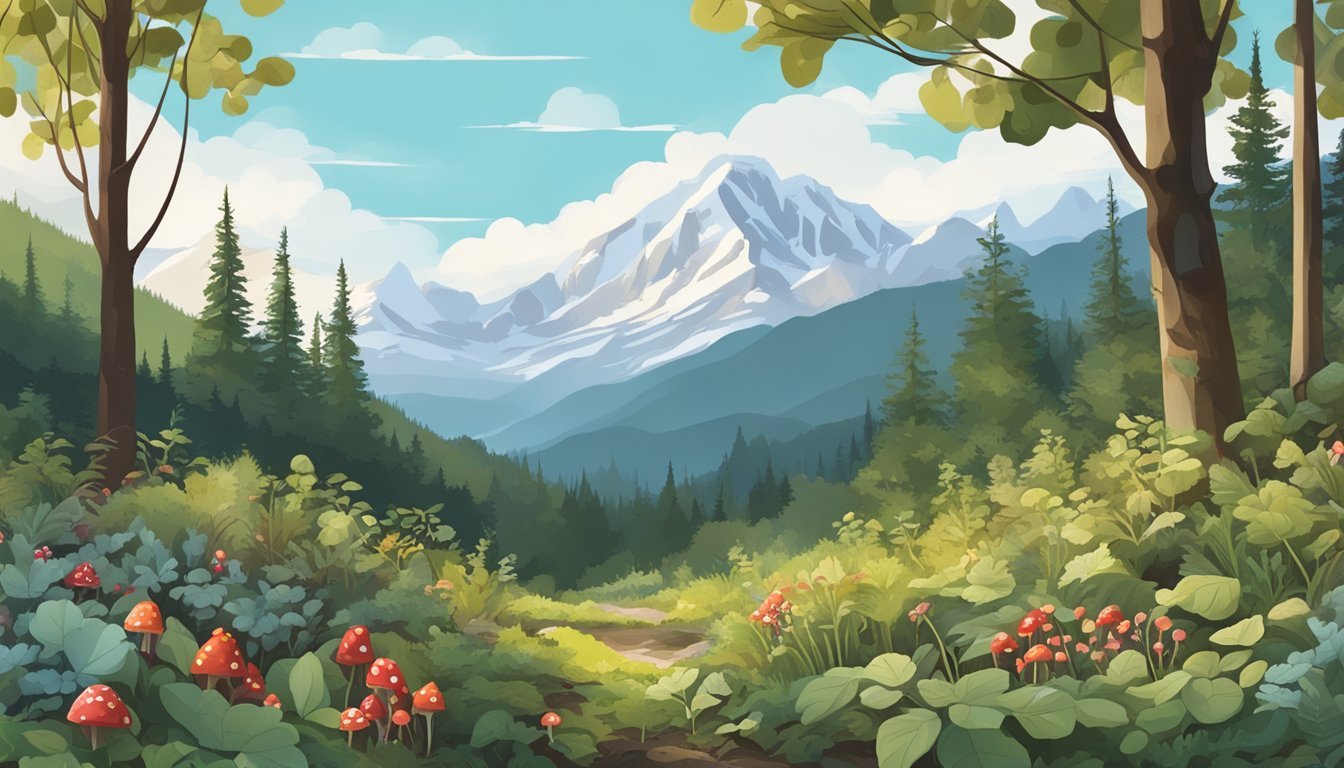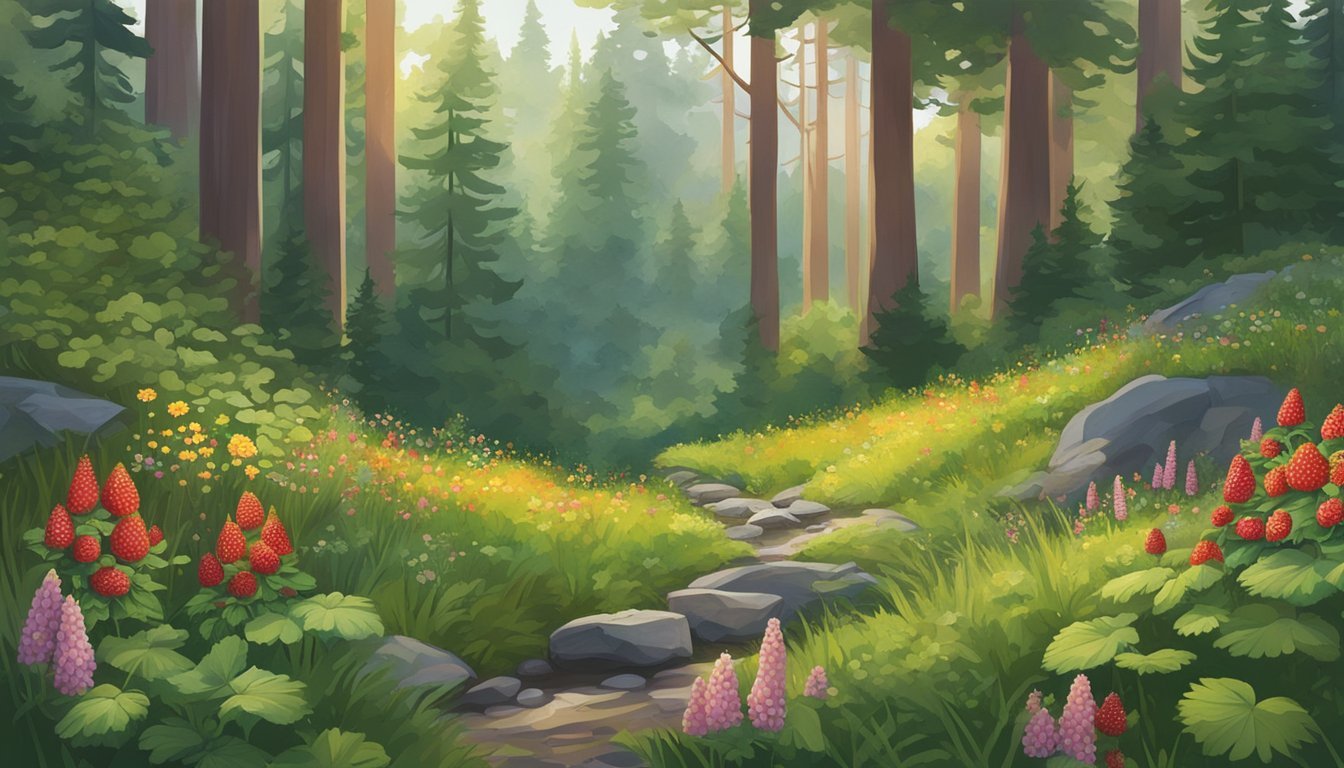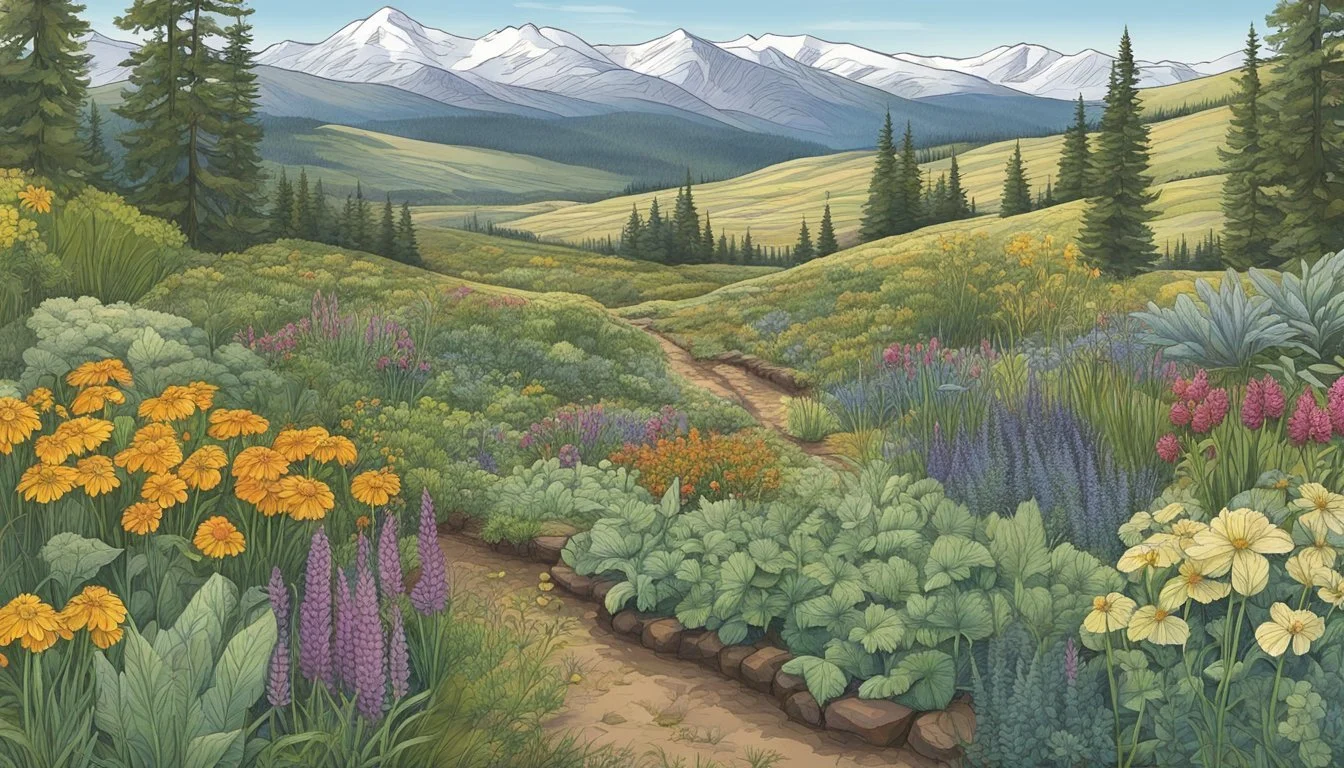Northern Rockies Native Edible Plants
A Guide to Foraging and Identification
The Northern Rockies host a remarkable variety of native edible plants, offering both sustenance and an opportunity to connect with the landscape. From the lush valleys to the high alpine areas, this region's biodiversity is fascinating. Foraging enthusiasts and naturalists alike will find that these edible plants not only contribute to a sustainable food source but also enrich their understanding of the native ecosystems in the Rocky Mountain region.
Among these native plants, wild berries and medicinal herbs hold a special place. Species like the buffalo berry, chokecherry, and elderberry are not just edible but also provide essential nutrients. The versatility of these plants, whether eaten raw, made into jams, or used in traditional medicinal practices, makes them invaluable to those exploring the Northern Rockies.
Beyond the berries, there are numerous greens and roots that have been staples for indigenous communities for centuries. Local favorites include arrowroot and wild onions, which are known for their flavor and nutritional benefits. By learning to identify and responsibly harvest these plants, foragers contribute to conservation efforts while enhancing their culinary experiences.
Identifying Edible Plants
It is crucial to learn how to confidently identify edible plants to safely enjoy nature’s bounty. Understanding key characteristics of safe plants and distinguishing them from poisonous counterparts is essential.
Key Characteristics of Edible Plants
Identifying edible plants often begins with recognizing specific features such as leaf shape, flower color, and berry clusters. Leaves might have a unique texture or vein pattern, like the serrated edges of nettles. Flowers, such as those of wild garlic, give off particular smells.
Certain edible weeds and shrubs exhibit distinctive growth patterns. For example, the Amelanchier alnifolia or serviceberry shrub, known for its sweet, dark purple berries, typically grows in wooded elevations. Observing environmental context can further help; plants thriving in clean, undisturbed habitats are more likely to be safe and nutritious.
Avoiding Poisonous Plants
Avoiding poisonous plants requires attention to specific warning signs. Many toxic plants like poison hemlock have distinct features: purple-spotted stems, fern-like leaves, and small white flowers.
Common poisonous berries include those from the Belladonna plant, noted for its bright purple-black berries and dark green, ovate leaves. Some harmful plants produce acrid or unpleasant odors when crushed. It’s key to cross-reference these physical and sensory clues using reputable sources. Avoid consuming any plant unless certain of its identification.
Using Guides and Resources
Accurate identification is supported through high-quality references. Field guides with detailed illustrations and photos are invaluable. Books like Linda Kershaw's "Edible and Medicinal Plants of the Rockies" provide in-depth information on both edible and poisonous species.
Digital resources also play a vital role. Websites dedicated to plant identification, offering databases and user-uploaded images, can be very helpful. Nature apps provide instant identification using smartphone cameras. When exploring new areas, carrying a combination of guides ensures a broader spectrum of reliable information.
Popular Edibles of the Northern Rockies
The Northern Rockies offer a rich tapestry of edible wild plants, ranging from flavorful berries to nutrient-packed roots and leafy greens. These plants not only provide sustenance but often carry medicinal benefits as well.
Berry-Bearing Plants
In the Northern Rockies, several berry-bearing plants are noteworthy for their edibility and health benefits. Huckleberries are a prized find, rich in vitamins A and C, and known for their sweet-tart flavor. These berries often grow in forested areas, and ripen from late summer to early fall.
Serviceberries (also known as Saskatoon berries) are another favorite, featuring a sweet flavor that can be enjoyed fresh or used in pies and preserves. Elderberries are smaller and can be quite tart; they are typically cooked before consumption and are often turned into syrups and jams.
Wild strawberries are less common but offer a burst of sweetness when found. These berries are high in antioxidants and can boost the nutritional value of a foraged meal.
Edible Roots and Tubers
Roots and tubers in the Northern Rockies are an essential part of the wild edible palette. Camas is a notable example, with its bluish flowers indicating the presence of this valuable root. Camas roots can be baked or boiled and provide significant nutritional value.
Kousa dogwood produces tubers that can be roasted much like potatoes, offering a starchy, nutrient-rich option. Yellow pond lily roots, found in wetland areas, are another example, typically dried and ground into flour.
Bitterroot is a well-known edible and was a staple for many indigenous tribes. Its root is typically boiled to reduce bitterness and can be an important source of carbohydrates.
Leafy Greens and Herbs
Leafy greens and herbs in the Northern Rockies are diverse and plentiful. Dandelion (Taraxacum officinale) is among the most common, with its leaves perfect for salads and rich in vitamins A, C, and K.
Tansy mustard is another edible green, often found in open fields. Its peppery leaves add spice to salads and can be cooked similarly to spinach.
Curly dock offers edible leaves that are tender when young and can be used in soups and stews. Yarrow, while primarily known for its medicinal properties, has young leaves that are edible and can be used sparingly in salads for a slightly bitter taste.
Seasonal Foraging
Foragers in the Northern Rockies can find a variety of edible plants throughout the year. Seasonal changes significantly influence which plants are available and at their peak for harvesting.
Spring Foraging
Spring offers a bounty of fresh, young greens and shoots ideal for foraging. Look for stinging nettles and wild lettuce, which are abundant during this time and provide nutritious greens. Delicate flowers like dandelions can also be collected, adding a mild, tangy flavor to salads.
Fiddlehead ferns are another early spring treat, best harvested when they are still tightly coiled. Chokecherry blossoms, with their mild floral essence, make for delightful additions to teas and syrups. Foragers should also watch for oregon grape shoots, which can be used in salads or as a cooked vegetable.
Summer Harvest
As summer progresses, the focus shifts to berries and fruits. Chokecherries, which start developing in summer, can be processed into jams and jellies. The oregon grape fruits ripen in this season, offering a tart flavor perfect for preserves. Wild raspberries and strawberries are also found in abundance.
In addition to fruits, summer is a fantastic time to harvest edible flowers like clover and wild rose petals. Medicinal plants like arnica, often found in the Colorado Rockies, can be foraged and used for making topical treatments. Verbena flowers, known for their calming properties, are another useful summer find.
Autumn Collection
Autumn is the time for roots and nuts. Foragers can dig for burdock roots and wild onions, which are both nutritious and flavorful. Nuts from oak trees, such as acorns, can be collected, leached of their tannins, and ground into flour. The cooler weather also makes it an ideal time to forage for matsutake mushrooms.
Manzanita berries also ripen in the fall, and their tart flavor can be used in drinks or porridges. The autumn fennel seeds, with their licorice taste, are perfect for adding to dishes for an extra burst of flavor. Always ensure proper identification before collecting any wild mushroom.
Winter Challenges
Winter foraging poses challenges due to snow cover and limited plant availability. Evergreens like pine and fir provide edible needles that can be made into a vitamin C-rich tea. Rose hips, which often remain on bushes throughout winter, are a crucial source of vitamins and can be used in teas or syrups.
Some hardy herbs like bay and wild sage may still be found, depending on the severity of the winter. Foragers should also know the location of perennials that store nutrients in underground parts, such as wild garlic bulbs. Care should be taken to forage sustainably, never taking more than what is needed.
Culinary Uses and Recipes
Wild edibles from the Northern Rockies offer a variety of unique flavors and textures. Culinary enthusiasts can prepare, cook, and preserve these plants in several delightful ways.
Preparation and Cooking
Several wild foods, such as purslane and arnica, can be consumed after simple preparation. Purslane leaves, stems, and buds are often added fresh to salads or lightly sautéed. When sautéing, add a bit of garlic and olive oil for enhanced flavor.
Arnica is typically used for medicinal purposes, but some regions use it in teas. Wild berries like huckleberries are delicious when eaten raw or cooked into desserts. Simple methods, such as boiling or steaming, allow the rich flavors to shine.
Fireweed shoots can be steamed or stir-fried. Adding lemon zest and salt can deepen the natural flavors. Use tender parts for a more delicate taste.
Preservation Techniques
Preservation ensures that wild foods can be enjoyed year-round. Berries, including huckleberries and serviceberries, are commonly made into jams, jellies, or dried.
To create a huckleberry jelly, boil the berries with sugar and lemon juice until thickened. Wild greens such as lamb's quarters or nettles can be blanched and then frozen, retaining their nutritional value for future use.
Herbs like yarrow and mint can be dried and stored in airtight containers. Drying is best done in a cool, dark place to maintain the herbs’ medicinal and culinary qualities.
Pickling is another method for preserving the flavors of wild edibles. Purslane can be pickled in a vinegar brine with spices, providing a tangy addition to meals.
Recipe Ideas
Incorporate wild edibles into familiar recipes for a unique twist. Purslane salad is enhanced with tomatoes, cucumber, and a light vinaigrette. For a warm dish, sauté purslane with garlic and olive oil, served over toasted bread.
Huckleberry muffins bring a burst of flavor to breakfast. Simply fold fresh or dried huckleberries into the muffin batter and bake.
Create a refreshing tea using fresh mint and yarrow. Steep the herbs in hot water for several minutes, then strain and enjoy hot or cold. This tea can also serve as a soothing remedy.
Experiment with fireweed shoots by adding them to stir-fries or as a side dish. They pair well with proteins like fish and chicken, making for a versatile ingredient.
Health Benefits and Nutritional Value
Northern Rockies native edible plants are rich in essential vitamins and minerals and offer numerous medicinal properties. These plants have been used traditionally for their health benefits and continue to be valuable food sources.
Vitamins and Minerals
Native edible plants in the Northern Rockies such as Amelanchier alnifolia (Saskatoon berry) and Urtica dioica (stinging nettle) are particularly nutrient-dense. Saskatoon berries provide high levels of vitamin C, dietary fiber, and antioxidants which contribute to overall health and support the immune system.
Stinging nettle is another powerhouse, offering a range of nutrients like vitamin A, C, K, and various B vitamins. Additionally, it is rich in iron, calcium, magnesium, and protein. These nutritional aspects make it beneficial for anemia, bone health, and overall vitality.
Betula papyrifera (paper birch) provides sap rich in manganese and a good source of hydration. Each plant contributes unique nutrients, making them excellent additions to a balanced diet.
Medicinal Properties
Several native plants possess strong medicinal properties. Arnica montana, commonly found in the Rockies, has been traditionally used to reduce inflammation and soothe muscle aches and sprains. It is typically applied topically as a cream or ointment to treat bruises and joint pain.
Stinging nettle serves not only as a nutritious food but also as a medicinal plant with diuretic properties, promoting kidney and liver health by aiding detoxification. It has also been used to relieve symptoms of arthritis and alleviate allergies.
Plants like Achillea millefolium (yarrow) are prized for their wound-healing properties, often used to stop bleeding and promote healing when applied externally. These plants are integral to traditional medicine and modern herbal practices.
Habitats and Ecosystems
The Northern Rockies house diverse habitats that foster unique wild plants, ranging from dense forests to moist riparian zones. These habitats support various plant species adapted to different environmental conditions.
Mountain and Forest Ecosystems
Mountain and forest ecosystems in the Northern Rockies, including regions in Colorado, Montana, Wyoming, and South Dakota, are rich in biodiversity. These ecosystems host numerous plant species such as Douglas fir, lodgepole pine, and aspen, which provide shelter and food for local wildlife. Wild plants like berries, herbs, and flowers thrive, adapting to varied elevations and climates.
High-elevation forests feature plants adapted to cold temperatures and lower oxygen levels. From the stunning subalpine meadows to the shaded forest floors, species like saskatoon berries and elderberries are common. These plants have evolved to endure harsh conditions and provide crucial resources, including nutrition for birds and mammals.
In the Rocky Mountains, these ecosystems create complex interdependencies between plants and animals. For example, the sugary sap from trees supports bird species, while the underbrush serves as protective shelter. This intricate web of life underscores the importance of preserving these natural habitats.
Riparian and Wetland Areas
Riparian and wetland areas in the Northern Rockies are lush, water-rich zones bordering rivers, lakes, and streams. These habitats support a different variety of plant species compared to upland areas. Plants such as willows, cottonwoods, and alder trees dominate these moist environments. The presence of consistent water sources helps these species flourish.
Wetlands provide crucial services like water filtration and flood control. They also host distinctive flora such as cattails and wildflowers adapted to saturated soils. Plants like wild mint and water-loving berries often grow along stream banks, contributing to the rich biodiversity.
These areas are essential for many bird and fish species. They rely on dense vegetation for nesting, feeding, and shelter. Conservation of riparian and wetland habitats ensures the survival of numerous plant species and maintains ecological balance.
Ethical Foraging and Conservation
Ethical foraging in the Northern Rockies requires careful consideration of sustainable practices and the impact on local wildlife. Responsible foragers respect the environment, ensuring the preservation of natural resources and habitats.
Sustainable Foraging Practices
Sustainable foraging practices are essential to maintain the delicate balance of ecosystems in the Rocky Mountain region. Foragers should harvest only what they need, ensuring not to over-collect from any one area. This prevents depletion of plant populations and allows ecosystems to thrive.
Key Practices:
Rotate Harvest Areas: Avoid collecting from the same spot repeatedly to give plants time to regenerate.
Leave Roots Intact: When possible, leave the root system undisturbed to promote regrowth.
Follow Laws and Guidelines: Adhere to local regulations about foraging to ensure it is done legally and respectfully.
Educate Yourself: Know which plants are endangered or protected and avoid them entirely.
Impact on Local Wildlife
The impact on local wildlife is a critical consideration in ethical foraging. Foragers must be mindful of the habitats and food sources for local fauna. Disruption of these can have serious consequences on wildlife populations.
Considerations for Wildlife:
Respect Habitats: Minimize disturbance to soil and surrounding environments which serve as critical habitats for many species.
Avoid Breeding Seasons: Limit foraging activities during breeding seasons when wildlife is vulnerable and sensitive to disturbances.
Balance with Nature: Ensure the foraging activities do not interfere with the natural availability of resources for animals, particularly in areas prone to drought.
Promote Biodiversity: Forage in a way that supports rather than depletes biodiversity, maintaining a healthy and sustainable environment for all.
By incorporating these principles, foragers can enjoy the bounty of the Northern Rockies while preserving its beauty and biodiversity for future generations.
Incorporating Wild Plants into Gardening
Incorporating native plants into your garden can enhance biodiversity and support local ecosystems. Additionally, using drought-resistant plants can help maintain a sustainable garden, especially in arid regions.
Creating a Native Edible Garden
Creating a native edible garden involves understanding which plants thrive in your region and how they can be integrated into your landscape. For instance, American cranberry is well-suited for northeastern climates with acidic, moist soils. This plant can be grown with a pH between 4.0 and 5.2, and it requires consistent moisture.
Wine cap mushrooms can also enrich the garden. These fungi help build soil, enhance water retention, and serve as an edible product. Their mycelium converts wood chips and mulch into nutrient-rich compost and creates a moisture-retentive layer that benefits other plants.
Purslane is another excellent choice due to its adaptability and nutritional value. This plant can be enjoyed fresh in salads or cooked in various dishes, providing a source of Omega-3 fatty acids and essential vitamins. Including such versatile plants can add both ecological and culinary value to your garden.
Drought-Resistant Landscaping
Drought-resistant landscaping is vital for maintaining a garden in areas prone to dry spells. Rocky Mountains native plants, such as certain wildflowers and shrubs, are often well adapted to these conditions. When establishing these plants, start by improving soil with organic compost to enhance structure and fertility.
Watering practices are crucial. Initially, regular watering helps plants establish themselves. Once mature, these plants typically require less water. For example, using mulch can help retain soil moisture, reducing the need for frequent irrigation.
Choosing drought-tolerant plants not only conserves water but also ensures that your garden remains vibrant through dry periods. This approach contributes to a sustainable and resilient garden environment.
Educational Resources and Community
Learning about native edible plants in the Northern Rockies is facilitated through a range of resources and community initiatives. These programs enhance knowledge and provide hands-on experience in foraging, often supported by educational workshops and local foraging networks.
Workshops and Guided Walks
Workshops and guided walks are crucial for anyone interested in identifying and utilizing native edible plants. Organizations often host these events to share expertise on local flora. Workshops typically cover topics such as plant identification, sustainable harvesting, and preparation techniques. For instance, the National Wildlife Federation conducts educational sessions that encourage outdoor learning and direct interaction with nature.
Guided walks take participants along local trails and roads, providing a practical, in-the-field experience. Knowledgeable guides offer insights into the habitats and growth patterns of various edible plants. These hands-on experiences are invaluable for beginners and seasoned foragers alike, helping to deepen their understanding and confidence in foraging.
Local Foraging Groups and Networks
Local foraging groups and networks create a sense of community among enthusiasts. These groups often organize regular meet-ups, where members can share experiences and tips. They also frequently use social media platforms to connect, such as Facebook or Instagram, where they share events, resources, and photos of their finds.
These networks are particularly active in the Northern Rockies, where communities thrive on the shared knowledge of their natural surroundings. In Montana, for example, initiatives like Missoula’s Community Wildlife Habitat engage local residents in foraging activities and environmental stewardship. These collaborative efforts promote sustainable foraging practices and foster a deeper appreciation of the local ecosystem.











